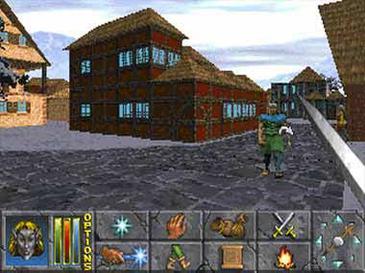I don't think there is a any gamer who doesn't know about The Elder Scrolls series and the date-11.11.11. As it's the release date of The Elder Scrolls V: Skyrim. As you know, before there was 1,2,3 and 4(obviously).
Here is a history of TES:
1.The Elder Scrolls I: Arena

The Elder Scrolls: Arena was released in 1994 and was the first game in The Elder Scrolls series and 12th game developed by Bethesda Softworks. It was one of the first roleplaying games of this type and definitely one of the largest for the time.
Gameplay:
Arena takes place in the continent of Tamriel, complete with wilderness, dungeons, and a spell creation system that allows players to mix various spell effects into a new spell as long as they have the money to pay for it.
Another notable part of Arena is its tendency to be unforgiving towards newer players. It is easy to die in the starting dungeon, as powerful enemies can be encountered if the player lingers too long. However, this effect slowly withers away as the player becomes more powerful and more aware of the threats that loom everywhere. Even Ken Rolston, lead designer of The Elder Scrolls III: Morrowind, says he started the game at least twenty times and only got out of the beginning dungeon once.
Arena is the only game in the series to let the player explore every province of Tamriel, the actual gameworld is quite a lot larger than Morrowind or Oblivion. The game utilizes randomly generated content to generate a massive world (around 6 million square kilometers), without much effort on the developers part. The world has hundreds of towns with several hundred dungeons, along with 17 specially designed dungeons that were part of the game's main quest.

Due to the enormity of the world, fast travel is essential. Walking to a nearby town could take up to 10 hours of real time, a far off town in another province could take several days.
The game is played from a first-person perspective. Combat is performed by clicking the right mouse button and dragging it across the screen, as if swinging your weapon. Magic is used by clicking on the magic menu, selecting your spell, and clicking where you want to shoot it. There is also the ability to pickpocket people on the street, or break into a store at night.
Arena was one of the first games to have a day and night cycle, with stores closing at night, people getting off the streets, and monsters wandering around towns at night.
The actual main quest is completed by finishing all 17 developer-made dungeons and completing the Staff of Chaos, but there are other quests as well. Asking about rumors in a town will lead to someone telling you about someone in a bar that may need help. These "miscellaneous" quests are very simple, ranging from simple deliverly mission to finding an artifact item after going through a dungeon.
**Arena is now free to download.
2: The Elder Scrolls II: Daggerfall
 Developed by Bethesda Softworks and released in 1996. It is a sequel to the CRPG The Elder Scrolls: Arena and the second installment in The Elder Scrolls series.
Developed by Bethesda Softworks and released in 1996. It is a sequel to the CRPG The Elder Scrolls: Arena and the second installment in The Elder Scrolls series.
Gameplay:
The key feature of Daggerfall as in all The Elder Scrolls games is the freedom the game offers to players. Players are free to play the game in any **** from an honorable knight to an evil assassin. Players are also free to stray from the main quest at anytime and can choose not to do it at all.
Daggerfall features a spell creation system where, through the Mages' Guild, players can mix a variety of different effects, such as fire damage and levitation, into custom spells. The game will then automatically generate the mana cost of the spell based on the power of the effects chosen. Daggerfall shipped with several spell effects that did not function correctly, or simply did not function at all, namely the transformations.
Other features include an equipment enchantment system (similar in concept to the spell creation system), the ability to buy houses and ships, vast amounts of clothing and equipment, dynamic political relationships between kingdoms, the ability to become a vampire, werewolf, or wereboar, and the combat system, which utilized mouse movement to determine the direction of sword swings in melee combat.
The political system is supported by a net of Guilds, orders, and religions, all with unique tasks and quests. Joining and contributing to these facilities allows the player to raise ranks and achieve higher reputation in the game world. According to one's reputation, NPCs in Daggerfall will react differently (for example, over time nobles will be more well-mannered with the Player character if he's a high-rank Knight or Royal Guard).

Daggerfall featured nudity prominently, both on NPCs (particularly witches and temple priestesses) and on your character's portrait when you removed all of your equipment. Options to turn off both nudity and blood are available.
Daggerfall is the largest Elder Scrolls game to date, featuring a game world estimated as being 161,600 square Kilometres (63,125 square miles) — roughly twice the size of Great Britain — with over 15,000 towns, cities, villages, and dungeons for the player's character to explore. According to Todd Howard, Elder Scrolls programmer, the game's sequel, The Elder Scrolls III: Morrowind is 0.01% the size of Daggerfall, but it should be noted most of Daggerfall's terrain was randomly generated.
An automap was implemented to help players navigate through the lengthy tombs and ancient underground fortresses. Players have to visit approximately 6-8 areas in order to finish the game, although a total of 47 areas are present.





Log in to comment